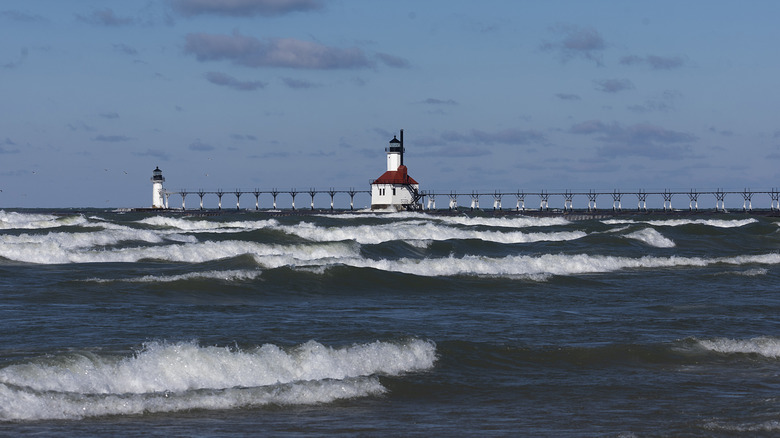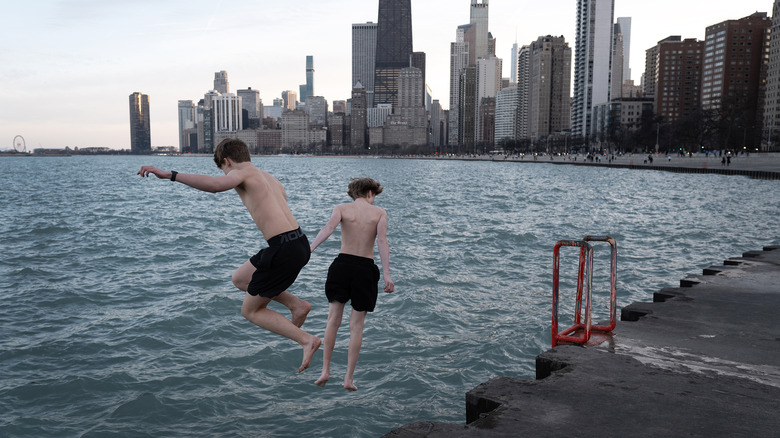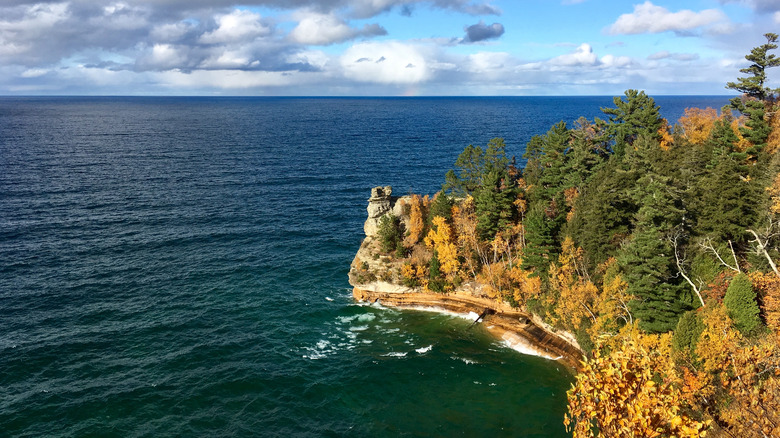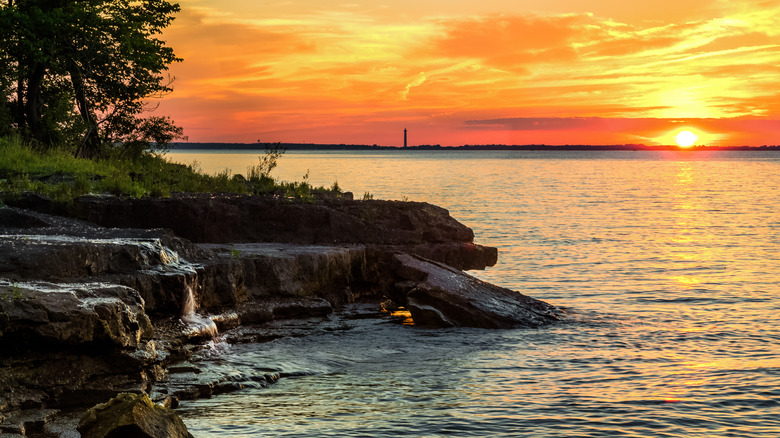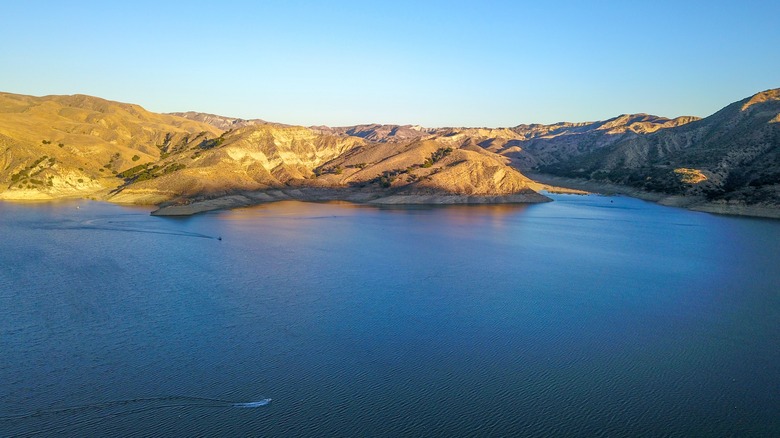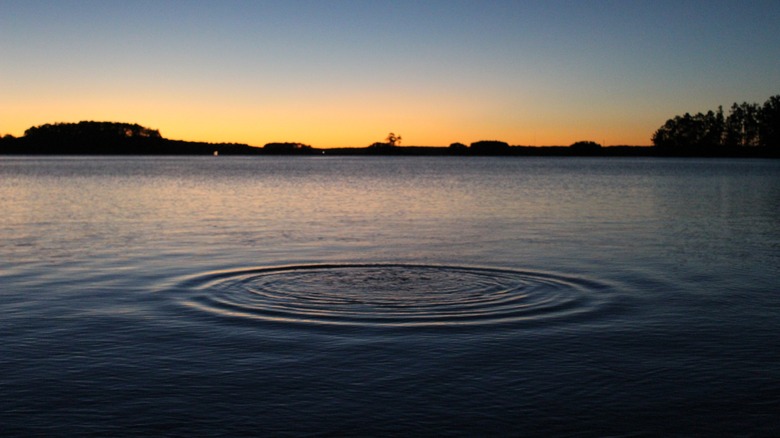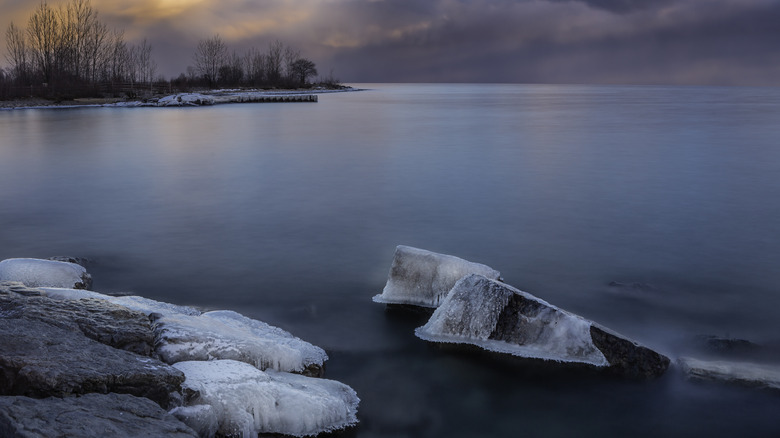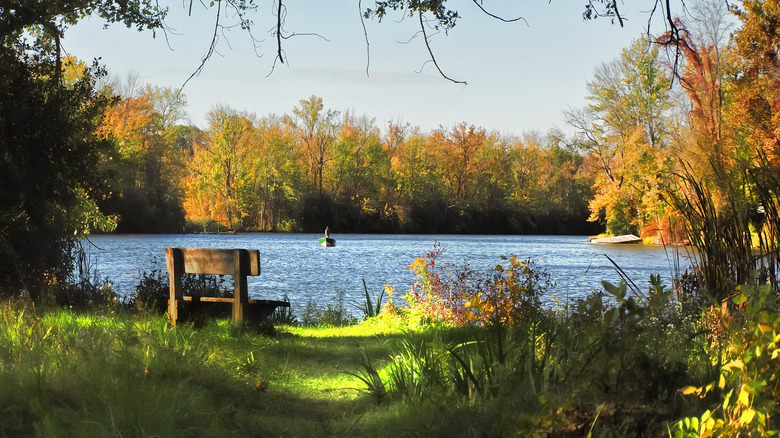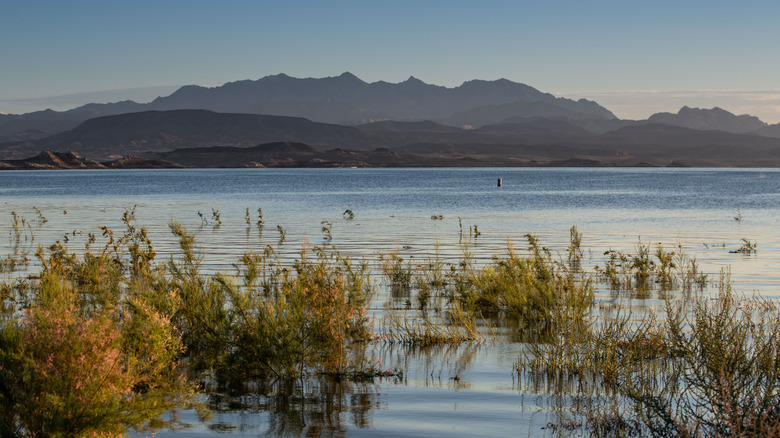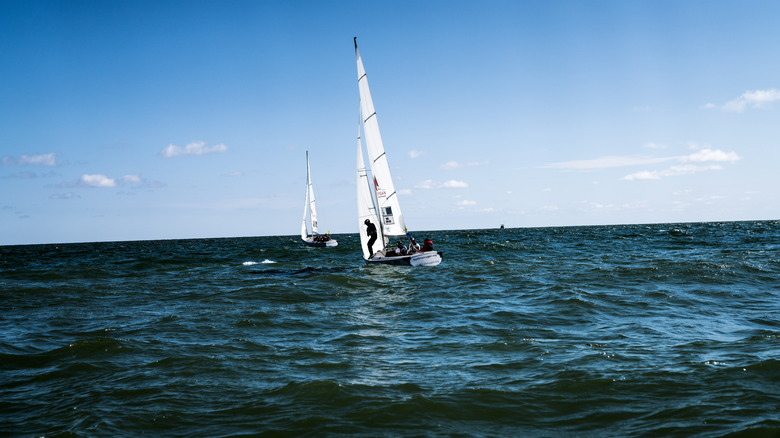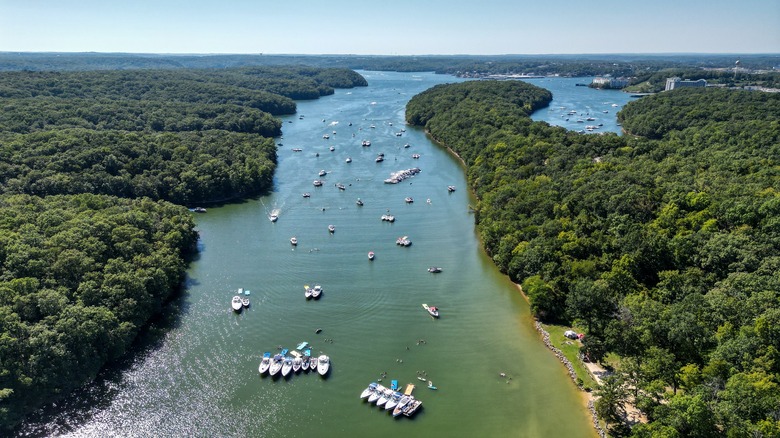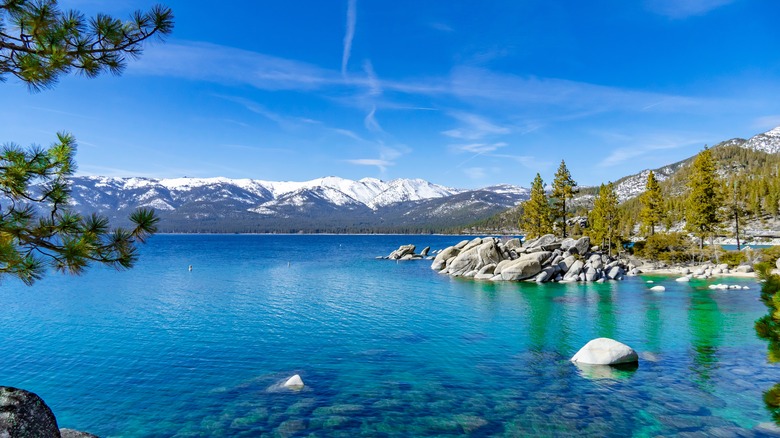Think Twice Before Swimming In These Dangerous US Lakes
Even if you live inland and away from the bright, shiny beaches of the coast, America's majestic selection of lakes offers plenty of entertainment during the summer months and beyond. From the Midwest's most stunning lakes to a resort tucked away in Colorado that will make you feel like you're at Italy's Lake Como, it's not hard to see why locals and tourists flock to these locations.
However, hidden dangers often lurk beneath the crystalline surface, and lakes can be just as perilous (if not more so) than the open waters of the Atlantic. It may be difficult to imagine anything sinister happening on a summer's day when the likes of California's Lake Piru and the Lake of the Ozarks are piled high with sailors, swimmers, tubers, and everything in between. But make no mistake — heading out onto the water isn't always a carefree good time. Everything from recurrent drownings, powerful riptides, and even toxins and pollutants make some of America's most popular lakes dicey and dangerous, even when the sun is shining and the drinks are flowing. After all, the statistics don't lie.
Lake Michigan
Lake Michigan's reputation is known across the world as it's one of America's biggest bodies of water. The sheer vastness of the lake alone is enough to explain its notoriety, but while its 321-mile length is impressive and alluring, swimmers shouldn't venture into its waters without considering the dangers.
In August 2022, ABC57 reported that at least 38 people had drowned on the lake so far that year, making Lake Michigan the most fatal of America's five Great Lakes. In the summer of 2024, reports revealed that several drownings had taken place on the lake, one stemming from the sinking of a sailboat. Despite wearing a lifejacket, the deceased didn't make it. Another event occurred when a teenage boy died after the sinking of a raft. An onlooker told NBC 5 Chicago, "I heard somebody yelling help. It's traumatizing to see this and to see that happen is going to stick with me for quite some time."
Swimmers should always be aware that large bodies of water like Lake Michigan are prone to sudden current changes. Riptides can be difficult to swim out of if you don't know how to handle them, and longshore currents can find even the most confident swimmers unable to get their bearings or evade getting trapped around buoys, walls, and other obstacles that make be in the lake.
Lake Superior
It could be argued that Lake Superior gets the best of both worlds. On one side, it borders the Great White North, while also nestling in against Minnesota, Wisconsin, and Michigan. Its position makes it the perfect destination for Midwest folks looking to have a good time, but those in the know are all too aware that Lake Superior needs to be treated with the respect it deserves. Swimmers who find themselves in trouble in the blue waters don't always make it to safety, making this one of the deadliest lakes in the country.
At the time of writing, there had already been several deaths on the lake in 2024 alone. In July, a 14-year-old was swimming close to Lake Superior State Campground with a 15-year-old friend when they found themselves swept away by an undertow. The older child managed to find their way to safety, while the current pulled the other further into the lake's choppy waters. They were found by divers the following day.
Lake Erie
When the sun sets along Lake Erie, it can look like heaven on earth. However, tranquil shots, such as the one above, can easily fool water lovers into thinking there's nothing to be scared of. While it's true that the 11 million visitors to its Ohio shores alone each year enjoy their time and get out unscathed, tragic cases still arise. In 2024, several swimmers fell victim to Lake Erie, including a 32-year-old man in Windsor-Essex County and an 11-year-old boy who had been enjoying a day out at Euclid Beach, Cleveland, when he got into trouble in the water after trying to help another child.
"I heard he went back into the water to save the little girl in the pink swimsuit," Anthony Lenix Jr.'s mother told ABC News 5 Cleveland. "Some people helped her out of the water, but no one was able to get back to my son. I tried. I couldn't get out there."
Not only are the currents a force to be reckoned with, but the local wildlife can be an issue in certain spots, too. In August 2024, visitors to the lake in Erie, Pennsylvania, reported the presence of an unwelcome swimmer: an alligator. The sightings quickly spurred authorities to issue a warning to those looking to take a paddle.
Lake Piru
West Coast residents have some gorgeous California beaches to choose from if they want to go and lounge on the sand and soak up the sun. However, for local boaters and swimmers, Lake Piru is often a popular spot. Close to the bustling city of Santa Clarita, the lake offers a slice of peace and tranquility away from the bright lights of Los Angeles County.
The lake became notorious worldwide in 2020 after "Glee" actress Naya Rivera went missing on a boating trip with her young son, Josey Hollis Dorsey. Four-year-old Dorsey told investigators that his mother helped him back onto the boat they had rented, but couldn't save herself. Sadly, her body was found several days later and it was determined she had drowned.
This tragic accident stirred new interest in Lake Piru, as Rivera wasn't the first visitor to succumb to its dark waters. The lake is manmade, having been flooded in 1955. As a result, old trees reach up from the lakebed, which can cause trouble for unsuspecting swimmers. Many stories of fatalities have plagued the lake over the years, and it's not unusual for victims to remain missing for long stretches of time. For example, when Vy Xuan Dong disappeared on a swimming trip in 2000, he wasn't found until nearly a month had passed.
Lake Lanier
Lake Lanier's history is so interesting that it's gained a reputation for being haunted. In 2023 alone, 13 people died on the lake, making it somewhat of a hotspot for fatalities. However, visitors still flock to the shores of the Georgia beauty spot, some for swimming, others to spend a few hours fishing or boating. But it begs the question, why do people think Lake Lanier specifically is haunted, when other lakes such as Lake Michigan have a much higher death rate?
It goes back to 1912 when a young woman named Mae Crow was murdered in the area. As Crow was white and four black men were suspected of the atrocity, it stirred racial tension in the town of Oscarville, resulting in one man, Robert Edwards, being lynched for his alleged participation in the crime. The murder of Crow ultimately saw the destruction of Oscarville, and where the town once stood was flooded. Lake Lanier was born, and many believe the townsfolk still linger, angry at what became of their home.
Aside from the lake's eerie history, its waters make it a difficult place to swim. In 2023, Game Warder Cody Tanner told Fox 5 Atlanta, "A lot of people aren't used to swimming in choppy water. It's not like a pool out here. It's completely different, so you can get swept out pretty easy."
Lake Ontario
Lake Ontario may be the definition of beautiful, but deadly. One of the five Great Lakes, this vast expanse of water isn't nearly as big as some of its contemporaries, but it's still an impressive stretch at 193 miles long. As the lake borders Toronto and New York, both locations have had their fair share of fatalities over the years. In April 2024, a 14-year-old boy came into trouble as he swam with a friend near Ashbridges Bay Park in Toronto. Despite the intervention of passersby, the boy succumbed to the lake's powerful undertow. Similarly, in 2023, a 20-year-old woman drowned after she ventured into the lake to swim with a companion at Chimney Bluffs State Park in Wayne County, New York. These are just two examples out of many incidents of their kind over the years.
In 2022, Toronto authorities told CTV News, "It is not uncommon, during windy conditions and rough water, for there to be waves on the lake over 3 meters high." Because of the severity of the wind, water goers can find themselves swiftly pushed much further out than they intended to go.
For those wanting to make sure they swim safely, Monroe County's Ontario Beach Park has daily supervised swimming sessions throughout the summer. For up-to-date times, visit the City of Rochester website.
Onondaga Lake
While many lakes are considered dangerous due to unseen structures that lie beneath the surface, dangerous currents, and even their wildlife, Onondaga Lake is known for another sinister catch: pollution from industry, wastewater, and stormwater runoff. For decades, the water may have looked fine on the surface but was rife with toxins seeping into it from nearby built-up areas.
It was so terrible that a swim ban was introduced in 1940, much to the disappointment of tourists and locals alike who fell in love with the area. In the years that followed, the authorities began to focus their efforts on restoring Onondaga to its former glory, and largely, it worked. However, swimming is still effectively banned in an official capacity. That doesn't stop everyone, though.
In 2019, scientific researchers claimed that the decades-long clean-up operation was a success and that the lake was indeed safe for swimmers — at least, in some parts (via Syracuse.com). However, the lake's murky reputation has been difficult to shake, despite backing from the county's Department of Water Environmental Protection, and at the time of writing in August 2024, a beach area has yet to be installed.
Lake Mead
Though Lake Mead in Nevada has impressive scenery and inviting waters, you may want to avoid swimming there if statistics are anything to go by. When it comes to deaths, Lake Mead holds a near unbeatable record, not just for the lake itself, but for the surrounding national park area. In July 2024, The Sun revealed that 317 people perished there from 2007 to 2024.
"You think you're jumping out of your boat for a quick swim and you're going to swim back to your boat," John Haynes, a National Park Service employee told KTNV Las Vegas. "But because of high winds, all of a sudden, your boat is drifting away and you're stuck in the middle of the lake." If that isn't enough to rattle your bones, just wait.
In 2022, the body of an unidentified male was found stuffed into a barrel at Hemenway Harbor. Despite investigations and authorities releasing photographs of John Doe's clothing, at the time of writing in August 2024, they are no closer to finding out who the gunshot victim is. Due to the nature of how the body was disposed of, some believe it may be the handy work of the mob. When you factor all of this in, Lake Mead doesn't seem like such a sweet place to do a few lengths, does it?
Lake Huron
Unlike some other Great Lakes in Michigan, Lake Huron doesn't have an enormously high death rate, though it isn't non-existent. In 2024, a kayaker was found deceased after seemingly falling into the water without a lifejacket, while another tragedy occurred after a paddleboarder couldn't make it back onto her board. These incidences aren't as high in numbers as other lakes, but there's another factor that makes Lake Huron a dangerous choice for those looking to cool off. Not many people live in the locality, and its remote location adds to the risk swimmers take.
What's more, swimmers can fall afoul of pollution and dangerous toxins, if they're not careful. In spring 2024, a group of Oscoda, Michigan, residents banded together to test the water of Lake Huron, amid concerns of its quality. Though they were originally told that the foam coming to the beach was safe, their testing showed the opposite. "We found there is nothing natural about the PFAS foam in Lake Huron," Cathy Wusterbath told Bridge Michigan. PFAS, otherwise known as "forever chemicals" can have lasting health impacts on the body.
Lake of the Ozarks
Nestled in the rolling greenery of the Ozark mountains lies the grand Lake of the Ozarks. The sprawling body of water is a major tourist attraction during the summer months, with many locals earning their bread and butter during the peak season. However, though visitors may love soaking up the hot Missouri weather and taking a dip in the water, caution should be exercised — but perhaps not for the reasons you think.
In 2023, it was reported that the area was experiencing somewhat of a crime surge. Local Sheriff Tony Helms told The Kansas City Star that his beat was becoming overloaded. Helms was quick to state that his jail cells are often full to the brim during tourist season, though it never used to be that way. "When I started here, I never dreamed anything like this was happening," he told the publication. "I was a simple sheriff in what I thought was a small county — it's not."
According to him, authorities simply can't keep up with how many people are visiting. On top of that, the Missouri State Highway Patrol has responded to 38 incidents (including 4 fatalities) involving 63 persons on the lake since September 2023 (at the time of writing in August 2024).
Lake Tahoe
Due to its location on the border between California and Nevada, Lake Tahoe is one of the most famous lakes in America. The two states get exceedingly hot during the summer months, so locals flock to the area to cool off. Though it isn't the biggest lake in America by a long shot, Lake Tahoe's location is both a blessing and a curse. It's in an area prone to dangerous wildfires, so visitors are urged to be careful when lighting barbecues and other fires. At different times of the year, some restrictions limit what visitors can do.
Ryan Sommers, the chief of the North Tahoe Fire Protection District told the organization's website, "It only takes one thoughtless BBQ or tiki torch to potentially cause a catastrophic wildfire." We've all seen how devastating these wildfires can be, and how quickly they can spread. A day out swimming can soon turn into running for your life if you don't pay attention.
On the flip side of that, swimmers should also be mindful of the water temperature. Even though the sun may be beaming down during the summer months, Lake Tahoe's water can take time to heat up. Novice wild swimmers may not realize that a dip in the water at the wrong time can result in some perilous conditions, such as cold water shock.
